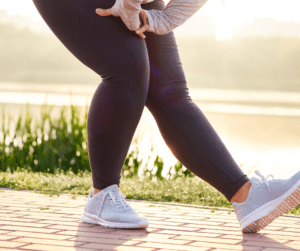The thought of “mobility training” is often thought of as a real waste of a good run day…
If for example, you struggle to just stand on one foot, these minuscule imbalances can accumulate during the thousands of repetitions on a normal run and increase your likelihood of getting those tight quads, hamstrings, and those niggly problem areas as well as increase your chances of gaining a serious injury and decrease your energy efficiency.
Usually, to counteract this, we add stretching and strength training to our routines – fantastic! But many of us still end up with aches and pains.
If this sounds familiar, we’re about to transform your running forever… with just two words… MOBILITY WORK.

Mobility Defined
Mobility is a term used to describe something’s ability to move and refers to the way your joints move inside their socket.
In essence, it is the ability to move your joints freely with the surrounding tissues allowing the movement to happen smoothly.
Mobility isn’t the same as flexibility, though it is close. Mobility incorporates flexibility and strength training.
A good way of understanding the difference between mobility and flexibility is to do this…
Make slow windmills/circles with any of your arms, and think about the way your shoulder is moving. Flexibility refers to the ability to lengthen a muscle in a stretch. Mobility refers to the range of motion of your joints, in this case, in your shoulder.

Why We All Need Mobility
According to the National Insitute on Aging (NIA), maintaining mobility and preventing disability are key to living independently as we age.
When people become less active, their muscles tighten, flexibility diminishes, and range of motion decreases.
Some joints are meant to be stable, while other joints in the body are meant to be more mobile.
A lack of adequate mobility in those joints can create imbalances that will probably result in compensated movements and increased risk of injury… for everyone and anyone not practicing mobility work.
Why Mobility Is SO Important For Runners
Mobility is absolutely vital to how well you run.
If you have tightness and poor mobility rather around your joints, it affects the quality of your stride, it also affects the power that you’re able to put into each of those strides.
By having a mobility limitation you are risking: How well you run & how fast you run.

By not doing mobility work you are increasing your risk of injury and it becomes more crucial as you age.
It’s very important for us ALL to be doing regular mobility work to keep ourselves in our stride and our running performance as optimal as possible.
Does Mobility Make You Run Faster?
Yes!
Including mobility work in your training plan will improve your running performance and decrease your risk for injuries, resulting in the possibility of improving your running speed.
Think about it, If your muscles and joints are able to move through the entire range of motion required with each stride, you will run efficiently, you’ll run fast and you’ll decrease your risk of injury. (I know we keep on repeating this, but it’s just incredible!)
All you need to do is have good mobility through your feet and ankles, knees, hips, and spine.
Mobility isn’t the same as flexibility, though it is close. Mobility incorporates flexibility and strength training.
We are HUGE advocates of mobility work here at Coach Parry and have created a mobility flow that you can do at home. You can access the mobility flow by clicking here.
Now that you know why mobility is so important, let’s dive into how often you should be doing the mobility work…
How Often You Should Include Mobility In Your Training
We always hear runners saying…” I’m not stretching after my run” or “ I’m not getting my flexibility in every day.”
This is where mobility and flexibility are probably the same…Mobility every day would be so beneficial to your running.
Here at Coach Parry, we are massive advocates of strength training, too and two to three strength sessions a week is probably ideal depending on your age and your ability.
Here at Coach Parry, we are massive advocates of strength training, too and two to three strength sessions a week is probably ideal depending on your age and your ability.
Making sure you do the correct strength training is important. The good news is we’ve created a free strength training plan for runners that you can download by clicking here.
With mobility, it’s not a case where less is more… it’s a case of more is more!

A lot of people often go … okay, well, this is yet another thing I now have to fit into my schedule… How on earth am I going to fit this in too?
Mobility work is something you can do as you wake up first thing in the morning, it’s quite a nice way to get yourself going for the day or before your run.
Let’s look at some of the areas that we should be focusing on from a mobility perspective.
Where Runners Should Be Focusing
Two of the main problem areas we tend to find in runners are poor ankle mobility, as well as poor hip mobility.
That’s not to neglect any upper body work. A really big focus that we like to incorporate is upper body or shoulder mobility rather, which will also have an effect on your running posture and how you keep yourself upright.
More often than not, we all work jobs that are stuck behind a desk, we might be slouched over quite a lot, and that all transfers into how tight we are and how immobile we are in our running posture.
If we look at lower limb and hip mobility as an example: You may have experienced a bit of knee pain in the past and what surprises people to find out is that more often than not… that pain is a referred pain from higher up in the chain.
The biggest problem experienced is poor hip mobility. If your hip flexors are tight, if your hips are immobile, what that’s doing is it creates a misalignment in how your muscles are contracting or pulling in one direction, and how your patella or your kneecap tracks in its groove.
So all of those aspects often come from one simple problem… hip mobility. If you can solve your hip mobility problems, you can get rid of your knee pain, unless it’s more of a trauma-focused type of knee pain.
Now that you know that mobility is one of those things that are going to impact your running.
We have put together a mobility flow series just for you! You can click here to download it now.
10 Benefits Of Mobility Training
- Improved joint range of motion.
- Improved circulation.
- Decreased risk of injury.
- These exercises can actually be a warm-up for your regular workout routine.
- Reduced muscle tension and soreness.
- They will add variety and change to your regular workout routine and help keep you motivated.
- Improved posture.
- Improved movement efficiency.
- These exercises tend to have a calming feeling & can help you release stress.
- Mobility training can help keep problems like back aches and knee pain away.




Comments are closed.